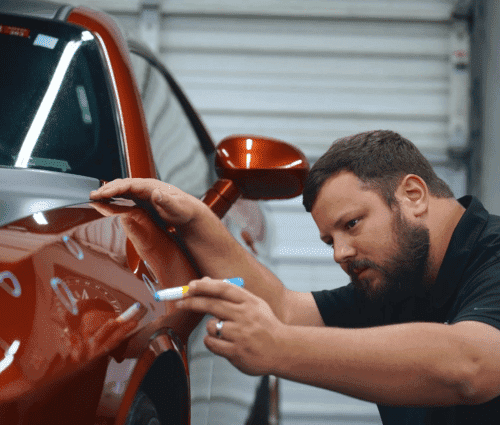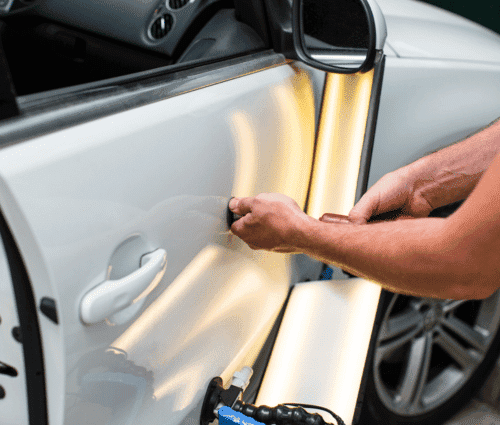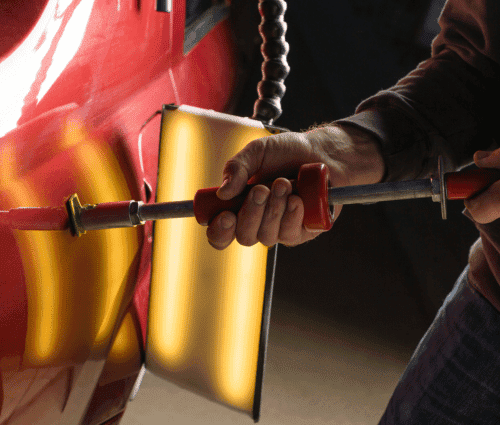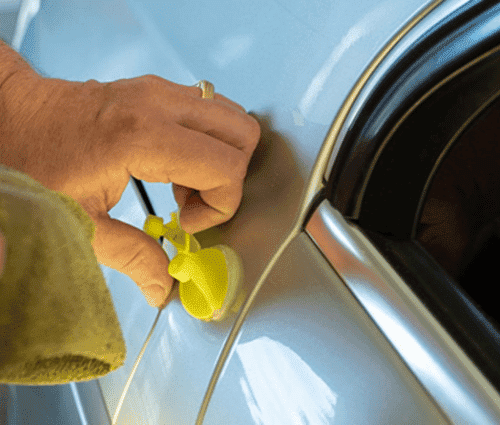How to Determine if Paintless Dent Removal is Right for Your Vehicle
Understanding Which Types of Dents Are Best Suited for PDR

When your vehicle has sustained dents from minor collisions or a hailstorm, you may wonder whether Paintless Dent Removal is the right choice for repairing the damage. PDR is an effective method for fixing small to medium-sized dents, especially when the paint remains intact. This technique is known for its quick turnaround time, affordability, and ability to restore your car’s original finish without the need for repainting or using fillers.
But how do you know if PDR is right for you? Not all dents are suitable for this method, so it’s important to understand the types of damage PDR can effectively repair. In this article, we’ll explore which dents are best suited for PDR and when you might need to consider traditional repair methods instead.

What Types of Vehicle Damage Can Paintless Dent Removal Effectively Repair?
Paintless Dent Removal (PDR) is highly effective at repairing small to medium-sized dents that haven’t damaged the paint. This method is particularly well-suited for minor damage caused by hail, door dings, shopping cart impacts, and other everyday incidents. In most cases, PDR can remove these dents completely, restoring the surface to its original condition without the need for sanding, filling, or repainting.
Dents caused by hailstorms are a common example of damage that can be fixed with PDR. Hailstones typically create shallow dents in the vehicle’s metal, but they rarely damage the paint. Since PDR works by massaging the metal from behind the surface, it’s ideal for fixing multiple small dents like those caused by hail.
Another type of damage that is suitable for PDR includes minor collisions or bumps that don’t crack or chip the paint. As long as the dent is not too deep and the metal is not stretched, PDR can effectively restore the car’s original shape. Vehicle owners with these types of dents will find that PDR is a fast, affordable, and minimally invasive solution.
When Paintless Dent Removal is Not the Best Option for Your Vehicle’s Repair

While PDR is a fantastic method for repairing certain types of damage, there are instances where it may not be the best option. If the dent is too deep, the metal has been severely stretched, or the paint has been cracked or chipped, PDR may not be suitable. In these cases, traditional repair methods will be needed the best results.
Paint damage is one of the key factors that can disqualify a dent from being a candidate for PDR. If the impact has caused the paint to crack or flake, PDR won’t be able to restore the surface without further damage to the paint.
The area would need to be sanded, filled with body filler, and repainted to match the surrounding color. Dents located near the edges of panels or those with sharp creases may be too complex for PDR.

These types of dents can distort the metal in ways that make it difficult to repair without traditional bodywork. In these situations, PDR might not achieve the desired results, and conventional repairs involving filler and repainting will likely be necessary.
How to Assess Whether Your Vehicle’s Dents Are Right?
For vehicle owners trying to determine if PDR is the right option, there are a few factors to consider when assessing the damage. First, check if the paint has been damaged. If the paint is intact and there are no signs of cracking, PDR is likely a good option. If the paint has been compromised, you’ll probably need to explore traditional repair methods to fix both the dent and the paintwork.
Consider the size and depth of the dent. PDR is most effective on smaller dents, usually ranging from the size of a dime to the size of a softball. If the dent is deeper or involves significant metal stretching, PDR may not be able to fully repair the damage. Shallow dents with no sharp creases are ideal candidates for PDR.
Think about the location of the dent. Dents in the middle of large, flat panels like the hood, roof, or doors are easier to repair using PDR. Dents near the edges of panels or in hard-to-reach areas may be more difficult to fix with this method. It’s also worth noting that PDR is more effective on steel and aluminum panels, so knowing the type of material your car’s panels are made of can help in the assessment process.
The Advantages of Using Paintless Dent Removal for Minor Vehicle Damage
One of the biggest advantages of Paintless Dent Removal (PDR) is its ability to restore a vehicle’s body without disturbing the original paint finish. This is important for maintaining the car’s value, as repainting can sometimes result in a slight color mismatch. With PDR, the vehicle retains its factory finish, which is especially important for newer cars or those with custom paint jobs.
Another significant benefit of PDR is that it’s much more cost-effective than traditional repair methods. Since PDR doesn’t require sanding, filling, or repainting, it eliminates the need for expensive materials and reduces labor costs.
This makes PDR a more affordable option for vehicle owners who want to fix minor dents without breaking the bank. PDR is also a much faster process than traditional dent repair.

Many PDR repairs can be completed in just a few hours, whereas conventional bodywork might take several days or even weeks, depending on the extent of the damage. For car owners who need their vehicles back quickly, PDR offers a convenient solution with minimal downtime.
Comparing Paintless Dent Removal Methods for Car Dents
When deciding between Paintless Dent Removal (PDR) and traditional repair methods, it’s important to consider the type of damage, cost, and time involved in each process. PDR is ideal for minor dents where the paint remains intact, offering a fast, affordable, and non-invasive repair option. In contrast, traditional repair methods are more suitable for more extensive damage or when the paint has been compromised.
Traditional repairs typically involve sanding down the damaged area, applying body filler, and repainting the surface to match the rest of the vehicle. While this method can effectively repair deeper dents or creased metal, it often results in higher costs and longer repair times. The use of body filler and repainting also increases the risk of color mismatches, which can affect the overall appearance of the vehicle.
How Vehicle Owners Can Determine if is this Right Choice

For vehicle owners trying to decide if Paintless Dent Removal (PDR) is the right option, there are a few steps to follow when evaluating the dents. First, look closely at the paint surrounding the dent. If the paint is intact and free from cracks or chips, PDR will likely be able to restore the dent without needing any additional paintwork. Measure the size and depth of the dent. PDR is most effective on shallow dents that range from dime-sized to about the size of a softball.
If the dent is deeper or has sharp edges, traditional repairs may be necessary to fully restore the vehicle’s surface. Examine the location of the dent on the vehicle. Dents in the middle of large, flat areas like the hood or doors are easier to repair using PDR, while dents located near edges or creases may be more challenging. If the dent is in an accessible spot and doesn’t involve any stretched metal, PDR is likely the best option for quick and cost-effective repair.

Why Paintless Dent Removal May Be the Right Solution for Your Vehicle
Paintless Dent Removal (PDR) is a highly effective and affordable solution for repairing minor dents caused by hail, door dings, and other common incidents. PDR is ideal when the paint remains intact, the dent is shallow, and the metal has not been severely stretched. It’s a faster and more cost-effective method compared to traditional bodywork, making it the preferred option for vehicle owners looking for a quick fix without sacrificing quality.
There are instances when PDR may not be suitable, such as when the paint is damaged or the dent is too deep.
Traditional repair methods may be required to achieve the best results. By carefully assessing the dent’s size, depth, and location, you can determine if PDR is the right choice for your vehicle and your car is restored to its original condition as quickly and affordably as possible.

VIP Hail Service | Plano, TX
Professional Hail Repair
Stay Up-to-date With Our Content
Subscribe to learn more about our mission!


